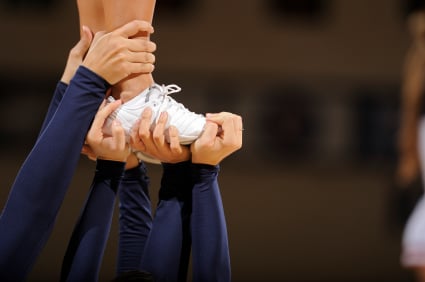 Pom-poms and ponytails make up only a portion of what cheerleaders do today. Standing on the sidelines and chanting a catchy phrase used to get the job done in a crazy fanatical crowd, but today flipping and throwing girls in the air is just part of the routine.
Pom-poms and ponytails make up only a portion of what cheerleaders do today. Standing on the sidelines and chanting a catchy phrase used to get the job done in a crazy fanatical crowd, but today flipping and throwing girls in the air is just part of the routine.
Because of the increase in skill and potentially dangerous stunts cheerleaders are performing today, there is a movement by the American Academy of Pediatrics and other concerned groups to designate cheerleading as a sport to improve the safety rules and create better supervision over the sport.
In a statement released this month, the AAP says that there needs to be better awareness about the rigors and risks of high school and college cheerleading so that cheerleaders can be subject to on-line athletic trainers, limits on practice times, and better qualified coaches.
Although the overall injury rate is lower than in girls participating in soccer, gymnastics, or field hockey, the rate of catastrophic injury which includes skull fractures and paralyzing spine injuries, is much higher.
Some schools have safety recommendations for high school and college cheerleading which includes limiting the height of a pyramid in high school to two and restricting routines including pyramids, tossing, or tumbling to be performed away from hard surfaces. Although these guidelines are helpful, many physicians and team leaders would like to see this mandated to keep cheerleaders safer.
This movement just recently ran into a major obstacle in August of 2012 when the 2nd US Circuit Court of Appeals ruled that cheerleading can not be considered a sport. For cheerleading to be considered a sport, it must have coaches, practices, competitions during a defined season and a governing organization. The key to this ruling was that cheerleaders don’t usually have competition as their primary goal, so they cannot be considered a sport.
Health professionals and sports advocates will continue to push for this safety regulation because they see the long-term benefits of it for those involved. For now, cheerleaders will have to develop careful individual standards.
Topics: Toadvine Enterprises, Kentucky athletic equipment, cheerleading a sport, cheerleading equipment
Get Email Updates
About this Blog
Our blog is written for athletic directors and school superintendents of elementary schools, middle and high schools, as well as colleges and universities.
We blog about local sports and industry news, bleacher and stadium maintenance, and current projects we're working on. We encourage you to subscribe in the box above or share this blog with your friends!
Recent Posts
Posts by Topic
- Toadvine Enterprises (66)
- Athletic Equipment (26)
- stadium seating (24)
- Kentucky athletic equipment (22)
- Kentucky athletics (22)
- Bleacher maintenance (19)
- bleacher design (14)
- Dant Clayton (12)
- Porter Athletics (12)
- bleacher inspections (9)
- indoor seating (9)
- basketball season (8)
- outdoor seating (8)
- sports equipment (8)
- Fall sports in Kentucky (7)
- Football season (7)
- Indiana athletics (7)
- basketball bleachers (7)
- equipment maintenance (7)
- football bleachers (7)
- indoor bleachers (7)
- outdoor stadium seating (7)
- seating concepts (7)
- Basketball equipment (6)
- Porter and Gill (6)
- high school scoreboards (6)
- seating maintenance (6)
- Indiana athletics provider (5)
- Nevco (5)
- Tennessee athletics (5)
- Tennessee sporting goods (5)
- auditorium seating (5)
- bleachers (5)
- college stadium seating (5)
- football equipment (5)
- football stadium seating (5)
- gym equipment (5)
- Kentucky athletic programs (4)
- Maintenance Services (4)
- Track and Field Equipment (4)
- Trade shows (4)
- college sports (4)
- Athletic Directors (3)
- Commonwealth Stadium (3)
- Fall sports resources (3)
- Kentucky (3)
- Kentucky Basketball (3)
- Kentucky equipment maintenance (3)
- Kentucky sporting goods (3)
- Louisville sporting goods (3)
- Renovation (3)
- Stadium seating maintenance (3)
- Telescopic Bleacher Seating (3)
- Tennessee sports equipment (3)
- Toadvine Enterprises 24 hour response (3)
- Track and Field (3)
- advertising options for high schools (3)
- basketball scoreboards (3)
- custom projects (3)
- football bleacher (3)
- high school football bleachers (3)
- Advertising opportunities (2)
- Backrests (2)
- Baseball (2)
- Bleacher Finishes (2)
- Bleacher Maintenance/Inspection (2)
- Football Stadium (2)
- Gill Athletics (2)
- High school athletic equipment (2)
- Hybrid Precast Bleachers (2)
- Indoor scoreboards (2)
- Interkal (2)
- Kentucky athletics provider (2)
- Kentucky stadiums (2)
- Louisville Cardinals (2)
- March Madness (2)
- Merry Christmas (2)
- NCAA facts from toadvine (2)
- NCAA tournament (2)
- NFL (2)
- Nevco Scoreboards (2)
- Porter Athletics Volleyball (2)
- Porter Athletics gym equipment (2)
- Press Release (2)
- Projects (2)
- Recessed telescopic bleachers (2)
- SEC Tournament (2)
- Tennessee sports equipment manufacturers (2)
- Toadvine bleacher seating in Louisville (2)
- Toadvine hires sales professional (2)
- Toadvine new hires (2)
- UK (2)
- VIP seating (2)
- alum-a-stands (2)
- athletic bleachers (2)
- baseball bleachers (2)
- baseball equipment Kentucky (2)
- basketball goals (2)
- bleacher riser (2)
- bleacher safety (2)
- budgeting for high school sports (2)
- college outdoor seating (2)
- college scoreboards (2)
- equipment ordering (2)
- grandstand maintenance (2)
- high school sports advertising (2)
- high school stadium seating (2)
- monthly newsletter sign up (2)
- scoreboard sale (2)
- sports facilities (2)
- sports facility maintenance (2)
- 2016 (1)
- ACC (1)
- ATT Stadium (1)
- Ashland Paul G. Blazer Tomcats (1)
- Big Ten (1)
- Big Ten Conference (1)
- Bleacher Seating in Tennessee (1)
- Bullet Belt Speed Pulley (1)
- Bullet Belt System (1)
- Business Insider (1)
- Centre College (1)
- Chicago Cubs (1)
- Closure systems (1)
- Colosseum Two Chairs (1)
- Congratulations Cardinals (1)
- Dant Clayton vs Brand X (1)
- David Hedge (1)
- Dayton Flyers (1)
- Deck and Risers (1)
- Dick's Sporting Goods (1)
- Dicks Sporting Goods (1)
- DuPont Manual High School (1)
- Dynamic Trainer (1)
- Employment Opportunities (1)
- Fall Sports (1)
- Football goal posts (1)
- Generating Revenue (1)
- Generating money for school (1)
- Giants vs. Royals (1)
- Good Samaritan Initiative (1)
- Graeme McDowell (1)
- GreenGuard Certification (1)
- Gym Accessories (1)
- H-Style football goal post (1)
- Happy Thanksgiving (1)
- High school Athletic Directors (1)
- IBC Code (1)
- IRC Code (1)
- Indiana stadium seating (1)
- Insuring Your School Against Liability (1)
- Interkal Self Storing Aisle Rail (1)
- Iroquois Amphitheater (1)
- Javanon (1)
- Jim Furyk (1)
- Jobs in Sports (1)
- Jungle Bird (1)
- KASA (1)
- KASA trade show (1)
- KHSADA Conference (1)
- KSBA (1)
- KSPMA annual conference (1)
- Kentucky Wildcats (1)
- Kentucky Youth Soccer Experience (1)
- Kentucky football equipment (1)
- Kentucky high school baseball equipment (1)
- Kentucky residents bidders law (1)
- Kentucky soccer equipment (1)
- Lane Goodwin (1)
- Louisville Male High School (1)
- MLB (1)
- Manuel vs Male (1)
- MaxPreps (1)
- Middle Tennessee Blue Raiders (1)
- Mockingbird Valley (1)
- NBA (1)
- NCAA Champions (1)
- NFPA 101 Life Safety Code (1)
- NFPA Code (1)
- OTB (1)
- Ohio athletics (1)
- Overstock items for sale (1)
- Pop Belt (1)
- Portable Bleachers (1)
- Porter 25 year warranty (1)
- Porter Athletics Basketball (1)
- Porter equipment (1)
- Power Sprinter (1)
- PowerMax Sled (1)
- Powr-Rib II Volleyball system (1)
- Purdue Boilermarkers (1)
- Putnam Stadium restoration (1)
- Rant Sports (1)
- Reverse Fold Systems (1)
- Revolutionary Goal Post (1)
- SEC Dominance (1)
- Safety (1)
- Seating inspections (1)
- Soccer Stadium (1)
- Soccer equipment (1)
- Special promotion (1)
- Speed training (1)
- Sports arenas (1)
- Spring sports season (1)
- TSPMA (1)
- Tennessee stadium seating (1)
- Toadvine cleaning services (1)
- Toadvine projects (1)
- Toadvine territory (1)
- Toadvine welcomes Vince Pellegrino (1)
- Top 10 Kentucky sports programs (1)
- U.S. Open (1)
- UK resources (1)
- University of Maryland (1)
- UofL Cardinals (1)
- UofL resources (1)
- Upward (1)
- Vince Pellegrino (1)
- Vine and Branch (1)
- Webb Simpson (1)
- Western Kentucky Hilltoppers (1)
- World Series 2014 (1)
- Wrigley Field Scoreboard (1)
- Wrigley scoreboard improvements (1)
- YMCA (1)
- angle frame bleachers (1)
- athletic locker rooms (1)
- athletic scholarships (1)
- baseball scoreboards (1)
- baseball stadium renovations (1)
- basketball cage (1)
- bleacher (1)
- bleacher closure systems (1)
- bleacher railing systems (1)
- bleachers for sale (1)
- bleachers maintenance (1)
- cheerleading a sport (1)
- cheerleading equipment (1)
- college sports scholarships (1)
- cool games for kids (1)
- custom bleacher seating (1)
- deck and riser systems (1)
- end-zone pylons (1)
- fantasy football (1)
- favorite arena (1)
- field hockey equipment (1)
- field hockey injuries (1)
- fully functioning weight rooms and locker rooms (1)
- fun summer alternative games (1)
- giving back (1)
- goal posts Kentucky (1)
- grandstand seating maintenance (1)
- gymnasium seating (1)
- high school football (1)
- high school rivalries (1)
- how to begin plyometrics (1)
- indoor volleyball (1)
- inside sales position at toadvine (1)
- join our team at toadvine (1)
- kentucky scoreboards (1)
- little league world series (1)
- loge box (1)
- loge box seats (1)
- loge boxes (1)
- maintenance on bleachers (1)
- message centers (1)
- newsletter winners announced (1)
- north oldham little league (1)
- online quote (1)
- ordering volleyball equipment (1)
- outdoor sports facilities (1)
- plyometrics equipment (1)
- recreational volleyball (1)
- request a quote (1)
- request an online quote (1)
- schedule a visit (1)
- school weight rooms (1)
- scoreboard inspections (1)
- scoreboard maintenance (1)
- shot clocks (1)
- soccer bleachers (1)
- sports equipment quote (1)
- stadium advertising opportunities (1)
- stadium seating inspection (1)
- stadium seating inspections (1)
- starting a plyometrics business (1)
- starting blocks (1)
- summer sports (1)
- toadvine is hiring (1)
- trade show reminder (1)
- uk athletics (1)
- uofl athletics (1)
- volleyball equipment (1)
- volleyball net sleeves (1)
- wall pad safety (1)
- wall pads (1)
- wooden bleachers (1)







Add Comment